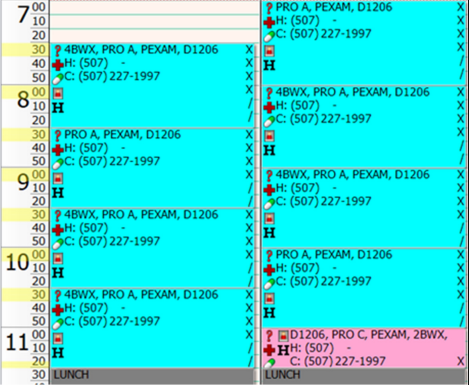We are seeing this all the time in our office visits; New patients may have to wait months to get in for a check-up and it’s very difficult to schedule Perio patients in a timely manner that represents the urgency and necessity of treating their infection. Also, recall is backlogged with little or no pursuit of past due recall patients. All this makes it hard to keep your active patient base cared for and active!
Ironically, the hygiene department may be jammed but their limited capacity affects how busy the doctors are – and their schedules may be relatively light.
A Quick Look at the Numbers
Conservatively, the average hygiene visit brings in $550 worth of treatment to a practice – around $180 in hygiene and $370 in doctor treatment to diagnose and deliver. The difference of even five hygiene visits a week can be a 10% difference in a typical solo practitioner’s production and even more than that for their bottom line.
“Assisted Hygiene is not Accelerated Hygiene.”
Using Assisted Hygiene just one ½ day per week per hygienist can therefore make a difference in your ability to deliver patient care. I have been polling hygienists on this and we know that many object offhand to Assisted Hygiene, but it is time to take a second look. Some key points:
- Appointments Stay the Same – 60 minutes.
- The Assistants and Hygienists Work Together – Doctors have Assistants, and it doesn’t hurt their quality. The same can go for Hygienists.
- You must be selective on which patients can fit into the Assisted Hygiene slots. This means that you do not schedule:
- Perio
- New Patients
- High Maintenance Patients
- Patients that are long overdue
With the Hygiene/Assistant team, there is always something to be done. Use interoffice communication to check in with each other and find a timely way to switch off. Make use of note templates to make documentation efficient and effortless.
Assisted Hygiene can be a very fun and effective way to meet the needs of your patient care.
Please see the example below. Of course, this can be modified to suit your office.
Ask your team to keep in mind the big picture…that an essential aspect of patient care is being able to see the patient! By keeping an open mind, giving each other a little grace in learning to adapt and roll, this model of care can really be a nice change up for the better.
The Three “C’s” of Assisted Hygiene:
- Control the Schedule:
- Patients need to fit specific criteria that the entire team is aware of
- 60-minute appointment lengths staggered at 30-minute intervals
- Incorporated elsewhere, blocks for new patients and SRP
- Communication:
- Assistants want clear, kind and concise direction from the hygienist. Use the Morning Huddle to get the team focused on today’s patients and reflect on what worked well or could have been improved from the previous day
- Cohesive:
- Assisted Hygiene is fluid. Be flexible. As much as you plan and set guidelines, there may be times when things do not go as planned. Use your full scope of practice within your licensure
And one more thing – the Doctor must do their part by getting to exams in a timely matter.

